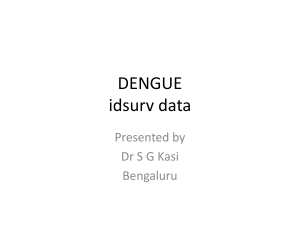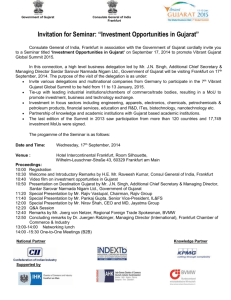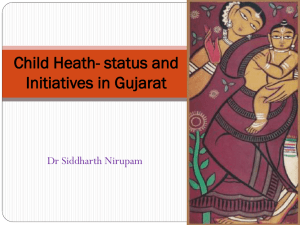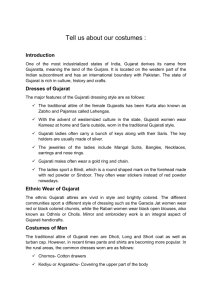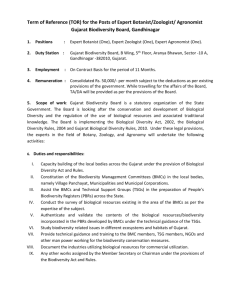The idea of Gujarat: History, ethnography and test
advertisement
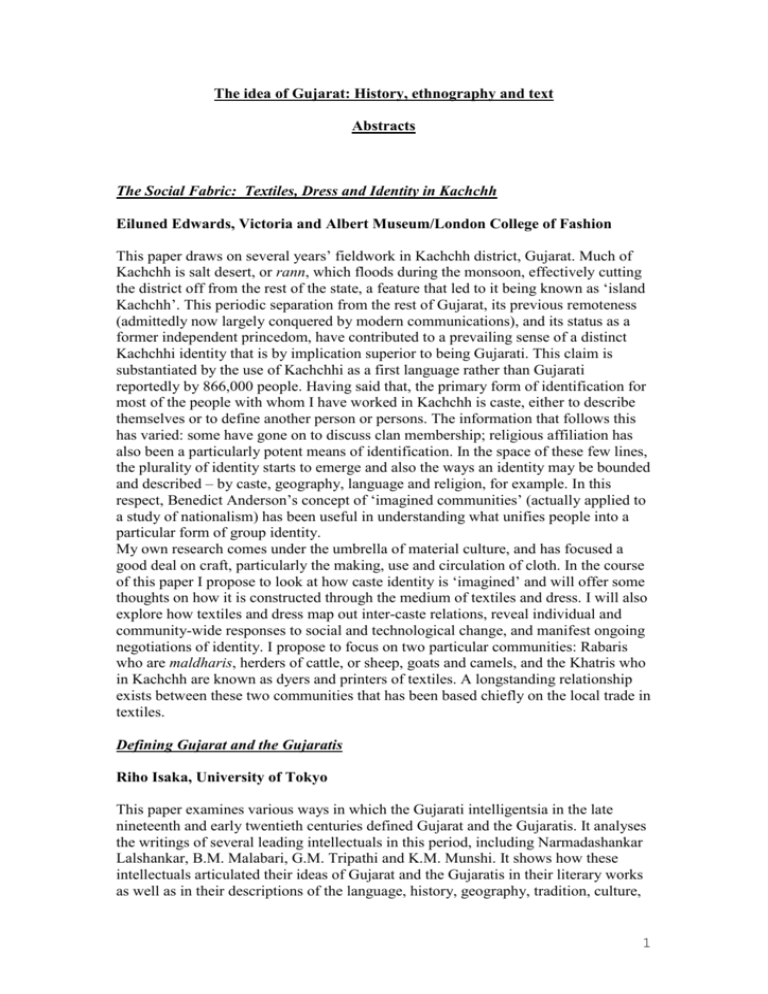
The idea of Gujarat: History, ethnography and text Abstracts The Social Fabric: Textiles, Dress and Identity in Kachchh Eiluned Edwards, Victoria and Albert Museum/London College of Fashion This paper draws on several years’ fieldwork in Kachchh district, Gujarat. Much of Kachchh is salt desert, or rann, which floods during the monsoon, effectively cutting the district off from the rest of the state, a feature that led to it being known as ‘island Kachchh’. This periodic separation from the rest of Gujarat, its previous remoteness (admittedly now largely conquered by modern communications), and its status as a former independent princedom, have contributed to a prevailing sense of a distinct Kachchhi identity that is by implication superior to being Gujarati. This claim is substantiated by the use of Kachchhi as a first language rather than Gujarati reportedly by 866,000 people. Having said that, the primary form of identification for most of the people with whom I have worked in Kachchh is caste, either to describe themselves or to define another person or persons. The information that follows this has varied: some have gone on to discuss clan membership; religious affiliation has also been a particularly potent means of identification. In the space of these few lines, the plurality of identity starts to emerge and also the ways an identity may be bounded and described – by caste, geography, language and religion, for example. In this respect, Benedict Anderson’s concept of ‘imagined communities’ (actually applied to a study of nationalism) has been useful in understanding what unifies people into a particular form of group identity. My own research comes under the umbrella of material culture, and has focused a good deal on craft, particularly the making, use and circulation of cloth. In the course of this paper I propose to look at how caste identity is ‘imagined’ and will offer some thoughts on how it is constructed through the medium of textiles and dress. I will also explore how textiles and dress map out inter-caste relations, reveal individual and community-wide responses to social and technological change, and manifest ongoing negotiations of identity. I propose to focus on two particular communities: Rabaris who are maldharis, herders of cattle, or sheep, goats and camels, and the Khatris who in Kachchh are known as dyers and printers of textiles. A longstanding relationship exists between these two communities that has been based chiefly on the local trade in textiles. Defining Gujarat and the Gujaratis Riho Isaka, University of Tokyo This paper examines various ways in which the Gujarati intelligentsia in the late nineteenth and early twentieth centuries defined Gujarat and the Gujaratis. It analyses the writings of several leading intellectuals in this period, including Narmadashankar Lalshankar, B.M. Malabari, G.M. Tripathi and K.M. Munshi. It shows how these intellectuals articulated their ideas of Gujarat and the Gujaratis in their literary works as well as in their descriptions of the language, history, geography, tradition, culture, 1 society and political and economic situations of Gujarat. While stressing the variety and fluidity of their notions of this region, the paper will also try to illustrate how some of their ideas were selected, appropriated and developed by the state and by different groups of people in the contemporary and later periods, to leave a significant influence on the social and political development of this region. In this regard, I will focus in particular on K.M. Munshi's writings on the history of Gujarat and on 'Gujaratni Asmita', and will examine the ways in which his words and concepts were appropriated by some political groups in the post-colonial period in their own attempts to redefine Gujarat and the Gujaratis. Contemporary Gujarat from an Ethnographic Perspective: Swaminarayan Bhakti and Some Considerations for Unpacking Assumptions about Religion and Religious Subjectivity Hanna Kim, New York University For many scholars of South Asia, contemporary Gujarat is explicitly connected to the unbearably tragic communal violence that has occurred on Gujarati soil in the recent past. Today’s Gujarat is in the challenging position of being seen as both economically thriving and politically problematic, and its productive Hindu middle classes and castes are under suspicion for their complicity in electing Hindutva leaders and supporting, tacitly or otherwise, fundamentalist agendas. In this uncertain political and social context, many organised Gujarati Hindu groups are facing pressure to clarify their positionality, that is, their organisation’s basis for existence, its means of sustaining its membership, and its relationship to fundamentalist projects. This paper directs attention to a prominent Gujarati devotional movement, the Bochasanwasi Shree Akshar Purushottam Swaminarayan Sanstha (or BAPS), in an effort to unpack some of the common assumptions about this community and to consider other ways of conceptualising a non-liberal bhakti tradition. Rather than trying to understand bhakti participation in sociological or reactive terms, this paper emphasises the need to look at BAPS followers and their actions as creatively engaged responses to a constantly changing environment. These responses point not only to the contingencies of modern Gujarati life but to the ways in which Swaminarayan bhakti tenets, themselves located in shifting historical and political contexts, make possible certain kinds of actions . In other words, it is not the discourse of fundamentalism, one that reinforces colonial tropes of passivity, insularity, and anti-intellectualism, which will prove useful for trying to locate the Swaminarayan community and its spheres of influence. For the analyst, this reframing of Swaminarayan bhakti raises certain critical questions: what assumptions about Hindu movements must be revised in order to move beyond the perceived alignment of devotional commitment with fundamentalist sympathies? What conditions might allow for a more peaceful coexistence of groups in Gujarat? What categories of being and action (including ideas of the past and present) emerge from Swaminarayan followers that compel a reimagining of the Gujarati political and social landscape? This paper suggests that understanding modern Gujarat requires a willingness to transcend certain liberal assumptions about religiously motivated behaviour and to consider the possibility that certain indigenous constructions might prove to be less divisive in the Gujarati context. 2 Moolk ain desh : Understanding spaces Sindhis of Gujarat inhabit Rita Kothari, Mudra Institute of Communications Ahmedabad My paper will examine two groups in their relation to “Gujarat” as a territory, a language, a nation, and more importantly, an idea that now manifests in a politically regionalized identity. I have worked on one of the groups in my earlier research – the Sindhi Hindus in urban parts of Gujarat. This paper contrasts the experience of social rejection and anxiety for assimilation among urban Sindhis with the rural Sindhis of the region of Banni in Kutch. The paradigm of contrast throws up oppositions of demography, class, and religion and runs into the risk of oversimplification. By way of avoiding the binary oppositions, I shall also discuss the case of a writer from Banni (who mediates the worlds of Sindhi Muslims, Sindhi Hindus and the “Kutchis”) in order to understand how fluid processes are un/consciously arrested by boundaries of languages and nations. Khari mata, stri ane rani: Introducing Queen Victoria to “The Gujarati population of India” John McLeod, University of Louisville What is the cradle of free India? Uttar Pradesh, where the rising at Meerut signaled the start of the First War of Independence in 1857? Maharashtra, where the first meeting of the Indian National Congress at Mumbai in 1885 marked the birth of the movement that led India to freedom? New Delhi, where Jawaharlal Nehru proclaimed the independence of India in 1947? If one state must be chosen, it is probably Gujarat. Gujarat is the land of M.K. Gandhi, who was born at Porbandar, educated at Rajkot, built his ashram on the banks of the Sabarmati, and led the Salt March to Dandi. It is also the land of Dadabhai Naoroji, the Grand Old Man of India, a Parsi from Navsari who inspired the first generation of Indian nationalists; of Sayajirao Gaekwad, the maharaja of Baroda whom the British accused of sedition and who may (or may not) have shown disrespect to King George V at the Delhi Durbar of 1911; and of Sardar Vallabhbhai Patel, who in the eyes of many was second only to the Mahatma as a driving force in the independence movement. Its role as the cradle of free India is unquestionably one of Gujarat’s identities, and thus a component of “the idea of Gujarat.” But as I frequently remind my students, for any conclusions one draws about India, there are always counter-examples that can be used to support an opposite conclusion. This paper examines what on the surface appears to be a counter-example of the idea of Gujarat as the cradle of free India, a Gujarati translation of Queen Victoria’s Leaves from the Journal of Our Life in the Highlands which was published in 1877 to introduce the “True Mother, Wife, and Queen” (khari mata, stri, ane rani) to “the Gujarati population of India.” The book would be completely forgotten today except for the fact that its translator was Mancherjee Merwanjee Bhownaggree (1851-1933), who two decades later went on to fame (or notoriety) as the second Indian member of the British Parliament. The paper begins with an exploration of the circumstances under which the book was translated and published, then considers its content, and finally examines its audience. It concludes that the “idea of Gujarat” embodied in the translation is not as distant from the notion of Gujarat as the cradle of free India as it seems at first glance. 3 Overlapping imaginations: Maha Gujarat and Maharashtra in the battle for Bombay Shreeyash Palshikar, Universities of Oxford and Edinburgh This paper explores the tensions between the overlapping ideas of Maha Gujarat and Maharashtra and the essentialized notions of Gujarati-ness and Marathi-ness created along with these ideas. It relates this imaginary overlap and these essentializations to the violence that accompanied the breakup of Bombay State and to the formation of the new states of Maharashtra and Gujarat in post-colonial India. The papers begins with a brief historical overview of the idea of Maha Gujarat in modern India by examining how ideas of the space of Maha Gujarat were symbolically, numerically, and verbally articulated in the publications of the Gujarat Research Society. Along with a spatial imagination, this paper argues that essentialized notions of Gujaratiness were created in the publications of the Gujarati Research Society. These ideas of essential Gujarati-ness and Marathi-ness were assumed by local politicians and also by influential politicians at the national level involved in the breakup of Bombay State. These assumptions about the essential natures of these peoples underlay political debates on the breakup of Bombay state from the local Bombay city level to the highest levels of the Indian government. These contributed to the national-level Congress leaders’ unwillingness to allow Bombay city to be included in any new Maharashtra state. Given these assumptions, violence committed by Gujaratis to promote the break-up of Bombay state and formation of Maha Gujarat surprised reporters and politicians. This paper concludes that these essential imaginings continue to be used by contemporary politicians. Mata, mandir and Muslims: Sacred space and its guardians in Gujarat Samira Sheikh, The Institute of Ismaili Studies The temple of Bahuchara Mata in north Gujarat celebrates a female deity with devotees from a range of sectarian, caste and even sexual affiliations (her attendants included eunuchs and nominally Muslim transvestites). Formerly within territory controlled by the sultans of Gujarat, the Mughals and the Marathas, the temple grew from a small local shrine into the centre of a pilgrimage network that now extends throughout Gujarat. In accounts of the temple’s history written from the sixteenth century onwards, those who held stakes in the temple’s reputation and revenues composed varying narratives of the temple and it’s past. One strand sought to retain the plurality of ritual practice at the temple while another sought to ‘reform’ it to fit normative Hindu standards. While the debate was phrased in ideological terms of tradition and reform, the paper argues that the actual conflict is over the prestige derived from the shrine and over its substantial pilgrim revenues. By exploring the religious, literary and economic dimensions of these debates during the transition from Mughal to Maratha to colonial rule, the paper suggests that the governance and control of sacred space was, and continues to be, an important component of the ‘idea of Gujarat’. 4 Nats and jamats in Bombay Presidency in the early nineteenth century Amrita Shodhan, Independent Scholar, London This paper will examine nats and jamats (collectives – sub-castes) as law makers and enforcers in the context of the introduction of colonial judiciary in Gujarat before the days of Henry Maine and the universal establishment of the Bengal model for the three presidencies. From 1818, Elphinstone and his mofussil administrators in Gujarat worked out a different model based on caste and customary law. While this was still reductive of the plurality found by them, it was a model that allowed for local logics to operate as they dealt with socio-political groups as polities – organisations with over-lapping and multi-centered sovereignties. The paper examines the working of castes in law in the context of the Khojas and Vaishnavas in Mumbai and Gujarat. Faith and religious behaviour became matters for discussion and criticism in the emerging public domain of newspapers, public assemblies and debating societies. An analysis of these ‘internal’ disputes and reform as well as legal cases suggests that, resolving them did not require a reference to singular, nationalised Hindu and Muslim identities but extended debates and compromises between the various powerful groups within the castes and their religious leaders. This study adds a different dimension to our understanding of caste in colonial administration and provides some depth to our knowledge of socialreligious organisation in Gujarat. Geographies of the past: The ethnographic history of Bhuj Edward Simpson, SOAS This iconic idea of Gujarat, essentially an outline map of Kutch, Saurashtra, and ‘Gujarat’ held together by the long straggling coastline, the artificially straight lines of the border with Pakistan, and the more organic but no less contested boundaries with 5 neighbouring states, is commonly used by politicians, industries, and conference organisers as a shorthand, and, apparently timeless, way of saying something about the identity of the state. In this paper, I examine the nature and substance of the western boundaries of Gujarat, those formed by Partition and by the lapping waves of the western Indian Ocean, in order to place the state within a different kind of imaginative and empirical geography, tying it to the broader history of Islam, politics, and trade with the lands and seas to the west, through the ethnography of today. I look at the formation, determination, and politicisation of these boundaries in terms of religion, commerce, and history, through the eyes of seafarers, merchants, and rajas. The argument suggests the boundaries are porous and malleable, sometimes in ways unique to Gujarat, and have been determined by a confluence of different intellectual and cultural traditions. I tell this story through the history of Bhuj, as a way of arguing with the jingoistic politicisation of the western border today, and the Indian nationalism of some recent scholarly historiography of the Indian Ocean. Equipping the laboratory for Hindutva: Religion and politics in Ahmedabad, 19002008 Howard Spodek, Temple University This paper will explore Gandhi's use of religion in politics in Ahmedabad; the views on religion and politics of the industrial elites; and the peculiar development of Hindutva in the past few years, as Hindutva-oriented politicians have quarreled bitterly among themselves in defining what they mean by Hindutva. Narrowing possibilities of stateness: The case of land in Gujarat Nikita Sud, QEH, University of Oxford This paper investigates the transformation of the Indian state from a stance of developmental interventionism towards increasing support for economic liberalisation. The definitional dilemma of ‘the state’ is resolved by constructing a conceptual map. This portrays the state as an idea, a system of government and as embedded in politics. The map forms the template for undertaking an empirical exploration. Ongoing changes in land policy in Gujarat provide a case study. Ostensibly, the state’s position has shifted from the active promotion of ‘land to the tiller’ to an ongoing disengagement from a liberalising landscape. However, re-evaluating this scenario against a multilayered conceptual map leads to conclusions against the grain of existing perceptions. State ideas of land serving the greater common good have continued into the post-liberalisation era, as has the petty land administration’s proprietariness, expressed in reluctance to fast track land transactions. At the same time powerful, alternative sets of ideas and institutional actions have come to the fore. These urge rapid land liberalisation to foster industrialisation, and have been promoted by the highest bureaucratic and political echelons. While the high state - big business alliance is neither new nor the only feature of the state today, it is perhaps the one with the most significant politico-economic consequences. This alliance represents not a homogenised pro liberalisation or pro big business state but one in which other possibilities of stateness have narrowed. The narrowing of the possibilities of 6 action within the still interventionist and dynamic state mark the liberalising landscape. Keywords: the state, India, economic liberalisation, land, Gujarat Between the sand and the sea: Reflections on the specificity of caste in Gujarat. Harald Tambs-Lyche, Université de Picardie-Jules Verne, Amiens, and LISSTCentre d’Anthropologie, Toulouse, France Gujarat is different, say the Gujaratis. So did my French colleagues when I stressed, years ago, that Gujarat did not fit Dumont's idea of hierarchy. Reflections on the specificity of caste in Gujarat are not new; Forbes (1878/1973), Thoothi (1935) and K.M. Munshi (1954) all deal with the theme, while the work of Pocock (1972/1973) and A.M. Shah (especially 1988) provides rich material on the particular form that caste has taken in the region. What I shall do here is, on the additional basis of my own work (1997, 2002, 2003, 2004), to attempt a synthesis of geographical, historical and sociological factors which have influenced the specificity of caste in the region, aiming less at originality - the elements I cite are all present in the literature - than at integration of the various contributions. The main thesis is based in geography: the location of the fertile plains of Central Gujarat between the Arabian Seas and the dry zone of Rajasthan produce two lasting influences in Gujarat history: the importance of merchant communities, exceptional for India and unusual in a wider context, and a strong center-periphery dimension, opposing the central plains and coastal South Gujarat to the less fertile regions of Saurashtra, Kacch, North Gujarat and the hilly Eastern boundary towards Rajasthan. The first factor greatly influences the overall hierarchy, with the high status of the merchant castes in the Centre: due to the other factor, however, Kshatriya dominance remained central to the understanding of the periphery at least until 1947. In many ways, then, centre and periphery constitute very different hierarchies, but regional dynamics imply that the two are closely associated. I have argued elsewhere (2002, 2003) that this opposition is central to the formation of the Rajput/Koli and Patidar/Kanbi blocks which compete in political and cultural terms. I shall argue that this factor also conditions the continuous, almost endless gradation of status that structures each block, as documented by Shah and Pocock. 7

